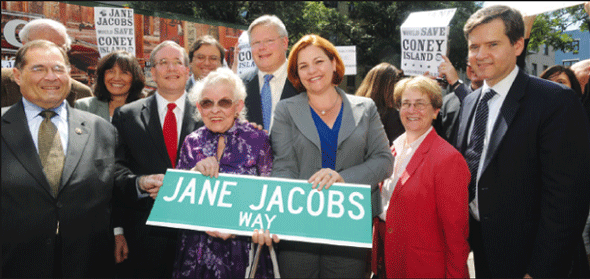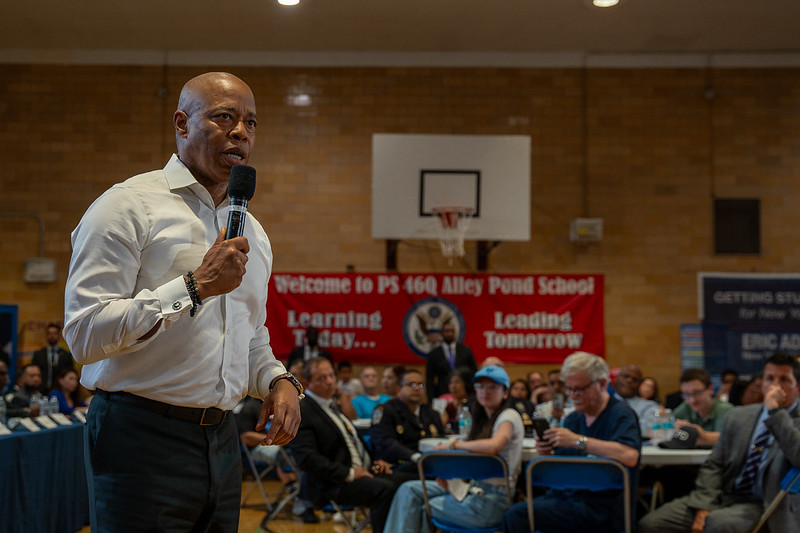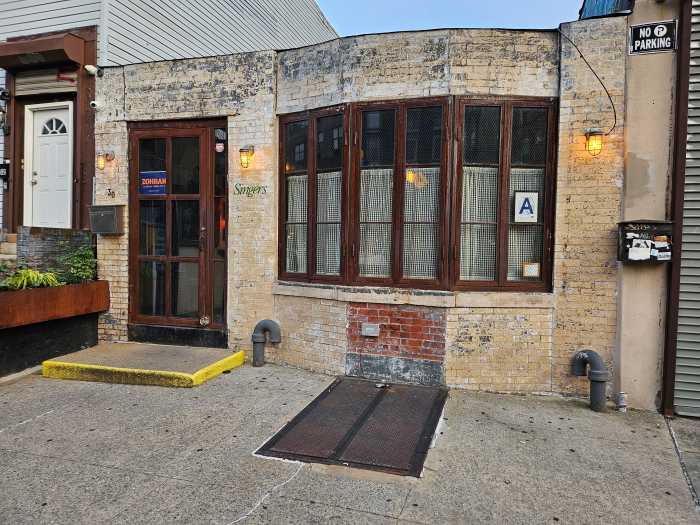By Albert Amateau
Jane Jacobs, gone from Greenwich Village these 40 years and gone from this life three years ago, was celebrated anew on Monday morning when a crowd of West Village neighbors and public officials gathered in front of the White Horse Tavern to unveil a commemorative street sign, “Jane Jacobs Way.”
A few people from Brooklyn added to the throng to protest the proposed Coney Island renewal plan; a former East Village woman came to denounce Mayor Bloomberg and City Council Speaker Christine Quinn.
Jane Jacobs, the foe of urban renewal and champion of neighborhoods and street life, would have loved it. She lived on the block at 555 Hudson St. with her family when she led the fight against Robert Moses’ 1962 proposal for a Lower Manhattan Expressway through the Village.
Doris Diether, the longest serving community board member (since 1964) in the city and a close ally of Jacobs in the battles to preserve Greenwich Village, was the guest of honor. Indeed, City Councilmember Alan Gerson referred to Diether as “Doris Jacobs” at one point. Quinn presented her with a replica of the “Jane Jacobs Way” street sign, and Diether was so moved that she was barely able to hold back the tears at the conclusion of her remarks.
The unveiling of the street sign on the southwest corner of Hudson and W. 11th Sts. didn’t go all that smoothly, either. The string separated from the sleeve covering the sign before it was completely unveiled, and for a while only “Jane” was visible. Tobi Bergman, a Community Board 2 member, borrowed a stepladder from the White Horse and completed the unveiling.
Jo Hamilton, newly elected chairperson of Community Board 2, was master of ceremonies, and recalled how Jacobs transformed thinking about urban life with her first book, “The Death and Life of Great Ameri-can Cities.” But she said the Village mostly claimed Jacobs as a friend who cared about her neighborhood.
Congressmember Jerrold Nadler paid tribute to Jacobs’s vision of a city that lives because of its diversity.
Protesters wearing Jane Jacobs-style glasses, wigs and clothes decried the Coney Island redevelopment plan, which they charge will shrink the existing entertainment area. Said Angie Pontani, a.k.a. Miss Cyclone, right, “It’s such a special place — you have to preserve it. The biggest threat is high-rise towers on Surf Ave.”
Manhattan Borough President Scott Stringer said that in the current irresponsible rush to development, “we must think of Jane Jacobs and figure out how to build for the future and preserve our wonderful neighborhoods.”
State Senator Tom Duane recalled reading Jane Jacobs’s books as a college student and being struck by the need to preserve neighborhoods and at the same time keep them dynamic.
Assemblymember Deborah Glick said Jacobs “came from a generation that refused to roll over — refused to accede to overdevelopment.”
Robert Tierney, head of the Landmarks Preservation Commission, said, “Preservation doesn’t come easy — it requires work and courage.” Tierney added that he was thrilled to be honoring Jane Jacobs in her own neighborhood where she was receiving the recognition she deserves.
Andrew Berman, director of the Greenwich Village Society for Historic Preservation, said later that he was not at the street-renaming ceremony because the organizers had not informed him in time, even though the society had proposed the renaming in 2006 shortly after Jacobs’s death.
“We’re glad that Jane Jacobs has finally received this long-overdue recognition of her immeasurable contribution to our neighborhood. An early member of the board of advisors of G.V.S.H.P., she continues to inspire our work every day,” Berman said later.
Before her death, Jacobs contributed an oral history to G.V.S.H.P., which is available on the society’s Web site, www.gvshp.org .
Jacobs, who came to New York in 1934 as Jane Butzner just out of high school from Scranton, Pa., to live with her sister in Brooklyn, soon discovered Greenwich Village, where low-rise buildings allowed people to see the sky and where pedestrians were not dominated by cars. She soon began writing articles for magazines, and in 1944 married the architect Robert Hyde Jacobs.
She left for Canada with her family in 1968 and went to Toronto to avoid having her sons drafted to serve in the Vietnam War. Jacobs was as much of an activist against destructive development in Toronto as she was in New York.






































